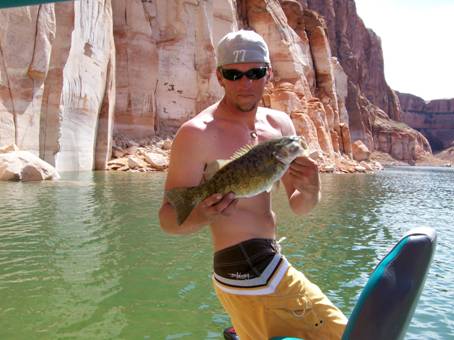|
|||
|
|
Lake Powell: An Amazing Fishery By Wayne GustavesonRunoff is slowing down, but the lake is still going up. The wall of incoming water still measures 87,000 acre-feet per day. That amount is double the spike flood released earlier in the year. Flood waters have muddied the water upstream from Bullfrog and picked all driftwood that has been resting on the shoreline for the past decade. As of mid-June, it was not a good idea to go upstream yet. However, by press time the water should have cleared, the wood settled, and fish have regained visibility. The good news is large shad spawn occurred in the upper lake. These small fish are protected from intense predation by low visibility. As soon as the small stripers can see shad, there will be day-long boils in the upper lake. In the lower lake the slurp boils are heating up. Tiny shad are being discovered in more and more canyons. Now Rock Creek has come alive with 8-12 inch stripers slurping in larval shad less than an inch long. These micro boils are going strong in Navajo Canyon, San Juan between Cha and Piute Canyons, Last Chance and other canyons yet to be discovered. There are many stripers that didn’t get the shad memo. They remain in the channels eating plankton. There has been a resurgence of steady catching at the Dam, Navajo Canyon, Padre Bay, Last Chance, Lake Canyon, Halls Creek at mouth and Moki Canyon mouth. If stripers elude your best efforts, realize that they are making a transition between the open clear water and shad water in the back of the canyon. When regular spots don’t produce, look toward the back of the canyon to find migrating stripers. The search image is changing from plankton to shad. Anchovies will work better in clear, deep water while a small white jig or small spoon may be better in the murky, shallower water. Bass should be settling down by press time into a summer pattern. There are small bass shallow on shore, but larger fish are randomly scattered enjoying the new brush forest they have been given by rising water. Walleye did not put on much of a show this spring. Now may be the time. In mid-June, the water temperature was at the point that walleye had become very active and were showing up in greater numbers than any time this spring. They seem to like the water in the 70s for stronger activity. Catfish are providing a strong evening fishery, and many bonus cats are being caught by anchovy fishermen whose bait gets too close to the bottom. Fishing is still great at this amazing fishery. Editor’s Note: At press time the lake elevation was 3,624 and the water temperature was 70-75F. |
|
|
 July 2008
July 2008 BIG SMALLMOUTH --Jared Mayfield, Copperton, Utah, is shown with his smallmouth bass caught on vertical structure while Lake Powell was rapidly rising.
BIG SMALLMOUTH --Jared Mayfield, Copperton, Utah, is shown with his smallmouth bass caught on vertical structure while Lake Powell was rapidly rising.